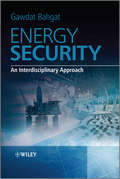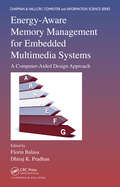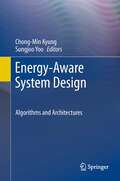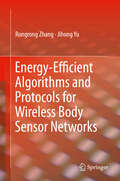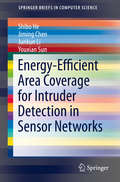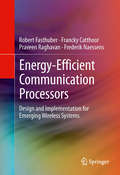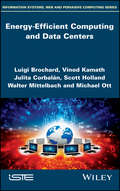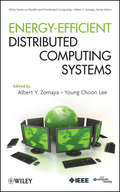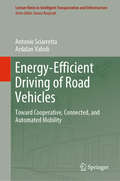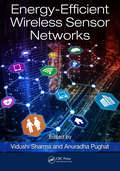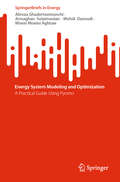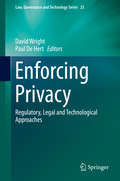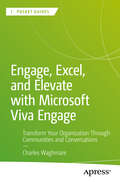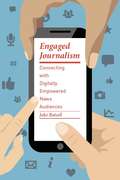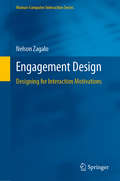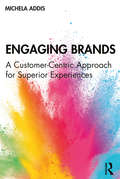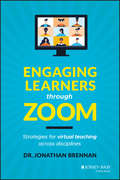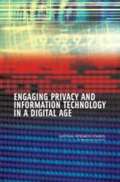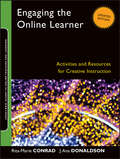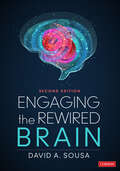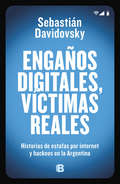- Table View
- List View
Energy Sector: A Systemic Analysis of Economy, Foreign Trade and Legal Regulations (Lecture Notes in Networks and Systems #44)
by Elena G. Popkova Oleg V. Inshakov Agnessa O. InshakovaThis book is a comprehensive economic and legal study of the theoretical and practical aspects of the problems of increasing energy efficiency; self-motivation of energy saving by business entities within the framework of their corporate responsibility; regulatory mechanisms to stimulate energy conservation in the economy; civil-law regulation of foreign trade turnover of energy resources between economic entities of the Russian Federation and companies of member states of international integration associations – the CIS, EEMP, the EU and BRICS. It argues that technological energy saving plays a key role in reducing the energy intensity and increasing the energy efficiency of the economy, and substantiates the need for institutional support – including legal support for the participation of the Russian Federation – in various forms of international cooperation. Lastly, based on an analysis of current legislation, programs and recommendations, judicial and contractual practices, customs and trade procedures, it offers proposals for the developing, improving and unifying civil law regulation of obligations in the sphere of international trade in energy resources, as well as methodological recommendations for drafting foreign trade contracts in the energy sector.
Energy Security
by Gawdat BahgatSecurity of Energy supply is a major concern for all modern societies, intensified by skyrocketing demand in India and China and increasing international competition over fossil fuel deposits. Energy Security: An Interdisciplinary Approach gives A comparative analysis from both consumers' and producers' perspectives. It uniquely combines economics, geology, international relations, business, history, public management and political science, in one comprehensive volume, highlighting the vulnerabilities and need to move to more sustainable energy sources.The author provides a number of useful case studies to demonstrate the theory, including perspectives from consuming regions such as the United States, the European Union, and China, and from exporting regions; the Middle East, Africa, Russia and the Caspian Sea.Key features include:coverage on theoretical and empirical frameworks so readers are able to analyse concepts relevant to new laws and policies in energy securityup-to-date coverage on 'green energy', outlining research on the balance between meeting energy needs and avoiding polluting the environmentan examination of the three most prominent international energy organizations; International Energy Agency, International Energy Forum, and Organization of Petroleum Exporting Countries a full Glossary listing all important terms used in the energy fieldThis study holds important information for policymakers, politicians, energy specialists, scientists and post-graduate and final year students of energy and international relations. With its clear written style, it will also engage other professionals who are interested in international political economy and the future of global energy.
Energy Sustainability through Retail Electricity Markets: The Power Trading Agent Competition (Power TAC) Experience (Applied Innovation and Technology Management)
by John Collins Andreas L. Symeonidis Wolfgang KetterThe world is moving away from demand-driven electricity markets supplied by centralized generation and distribution of fossil-fuel-produced electricity. Increasing reliance on weather-dependent renewable sources will require a shift toward a supply-driven paradigm, while beneficial electrification, including widespread adoption of electric vehicles, heat pumps, and batteries will offer considerable but widely distributed demand flexibility that can be used to compensate for supply variability. The open-source Power Trading Agent Competition (Power TAC) platform simulates a decentralized future, modeling the high complexity of future retail electricity markets. This book describes a variety of approaches to profitable trading in realistic wholesale and retail electricity markets. It presents actionable insights from extensive exploration of policies and business models for retail electricity markets gained from a decade of Power TAC tournaments, and from research inspired by the Power TAC experience. Featuring contributions from tournament designers, competitors, and scientists combining best practices from computer science and economics and management science, this book is of benefit to academics, researchers, practitioners and policy makers in sustainable energy and wholesale and retail electricity markets.
Energy-Aware Memory Management for Embedded Multimedia Systems: A Computer-Aided Design Approach (Chapman & Hall/CRC Computer and Information Science Series)
by Dhiraj K. Pradhan Florin BalasaEnergy-Aware Memory Management for Embedded Multimedia Systems: A Computer-Aided Design Approach presents recent computer-aided design (CAD) ideas that address memory management tasks, particularly the optimization of energy consumption in the memory subsystem. It explains how to efficiently implement CAD solutions, including theoretical methods an
Energy-Aware System Design
by Chong-Min Kyung Sungjoo YooPower consumption becomes the most important design goal in a wide range of electronic systems. There are two driving forces towards this trend: continuing device scaling and ever increasing demand of higher computing power. First, device scaling continues to satisfy Moore's law via a conventional way of scaling (More Moore) and a new way of exploiting the vertical integration (More than Moore). Second, mobile and IT convergence requires more computing power on the silicon chip than ever. Cell phones are now evolving towards mobile PC. PCs and data centers are becoming commodities in house and a must in industry. Both supply enabled by device scaling and demand triggered by the convergence trend realize more computation on chip (via multi-core, integration of diverse functionalities on mobile SoCs, etc.) and finally more power consumption incurring power-related issues and constraints. Energy-Aware System Design: Algorithms and Architectures provides state-of-the-art ideas for low power design methods from circuit, architecture to software level and offers design case studies in three fast growing areas of mobile storage, biomedical and security. Important topics and features: - Describes very recent advanced issues and methods for energy-aware design at each design level from circuit and architecture to algorithm level, and also covering important blocks including low power main memory subsystem and on-chip network at architecture level - Explains efficient power conversion and delivery which is becoming important as heterogeneous power sources are adopted for digital and non-digital parts - Investigates 3D die stacking emphasizing temperature awareness for better perspective on energy efficiency - Presents three practical energy-aware design case studies; novel storage device (e.g., solid state disk), biomedical electronics (e.g., cochlear and retina implants), and wireless surveillance camera systems. Researchers and engineers in the field of hardware and software design will find this book an excellent starting point to catch up with the state-of-the-art ideas of low power design.
Energy-Efficient Algorithms and Protocols for Wireless Body Sensor Networks
by Jihong Yu Rongrong ZhangThis book provides a systematic treatment of the theoretical foundation and algorithmic tools necessary in the design of energy-efficient algorithms and protocols in wireless body sensor networks (WBSNs). These problems addressed in the book are of both fundamental and practical importance. Specifically, the book delivers a comprehensive treatment on the following problems ranging from theoretical modeling and analysis, to practical algorithm design and optimization: energy-efficient clustering-based leader election algorithms in WBSNs; MAC protocol for duty-cycling WBSNs with concurrent traffic; multi-channel broadcast algorithms in duty-cycling WBSNs; and energy-efficient sleep scheduling algorithms in WBSNs. Target readers of the book are researchers and advanced-level engineering students interested in acquiring in-depth knowledge on the topic and on WBSNs and their applications, both from theoretical and engineering perspective.
Energy-Efficient Area Coverage for Intruder Detection in Sensor Networks
by Shibo He Jiming Chen Junkun Li Youxian SunThis Springer Brief presents recent research results on area coverage for intruder detection from an energy-efficient perspective. These results cover a variety of topics, including environmental surveillance and security monitoring. The authors also provide the background and range of applications for area coverage and elaborate on system models such as the formal definition of area coverage and sensing models. Several chapters focus on energy-efficient intruder detection and intruder trapping under the well-known binary sensing model, along with intruder trapping under the probabilistic sensing model. The brief illustrates efficient algorithms rotate the duty of each sensor to prolong the network lifetime and ensure intruder trapping performance. The brief concludes with future directions of the field. Designed for researchers and professionals working with wireless sensor networks, the brief also provides a wide range of applications which are also valuable for advanced-level students interested in efficiency and networking.
Energy-Efficient Communication Processors
by Francky Catthoor Praveen Raghavan Frederik Naessens Robert FasthuberThis book describes a new design approach for energy-efficient, Domain-Specific Instruction set Processor (DSIP) architectures for the wireless baseband domain. The innovative techniques presented enable co-design of algorithms, architectures and technology, for efficient implementation of the most advanced technologies. To demonstrate the feasibility of the author's design approach, case studies are included for crucial functionality of advanced wireless systems with increased computational performance, flexibility and reusability. Designers using this approach will benefit from reduced development/product costs and greater scalability to future process technology nodes.
Energy-Efficient Computing and Data Centers: Energy Efficient Computing And Data Centers
by Luigi Brochard Vinod Kamath Julita Corbalán Scott Holland Walter Mittelbach Michael OttData centers consume roughly 1% of the total electricity demand, while ICT as a whole consumes around 10%. Demand is growing exponentially and, left unchecked, will grow to an estimated increase of 20% or more by 2030. This book covers the energy consumption and minimization of the different data center components when running real workloads, taking into account the types of instructions executed by the servers. It presents the different air- and liquid-cooled technologies for servers and data centers with some real examples, including waste heat reuse through adsorption chillers, as well as the hardware and software used to measure, model and control energy. It computes and compares the Power Usage Effectiveness and the Total Cost of Ownership of new and existing data centers with different cooling designs, including free cooling and waste heat reuse leading to the Energy Reuse Effectiveness. The book concludes by demonstrating how a well-designed data center reusing waste heat to produce chilled water can reduce energy consumption by roughly 50%, and how renewable energy can be used to create net-zero energy data centers.
Energy-Efficient Distributed Computing Systems
by Albert Y. Zomaya Young-Choon LeeThe energy consumption issue in distributed computing systems raises various monetary, environmental and system performance concerns. Electricity consumption in the US doubled from 2000 to 2005. From a financial and environmental standpoint, reducing the consumption of electricity is important, yet these reforms must not lead to performance degradation of the computing systems. These contradicting constraints create a suite of complex problems that need to be resolved in order to lead to 'greener' distributed computing systems. This book brings together a group of outstanding researchers that investigate the different facets of green and energy efficient distributed computing. Key features: One of the first books of its kind Features latest research findings on emerging topics by well-known scientists Valuable research for grad students, postdocs, and researchers Research will greatly feed into other technologies and application domains
Energy-Efficient Driving of Road Vehicles: Toward Cooperative, Connected, and Automated Mobility (Lecture Notes in Intelligent Transportation and Infrastructure)
by Antonio Sciarretta Ardalan VahidiThis book elaborates the science and engineering basis for energy-efficient driving in conventional and autonomous cars. After covering the physics of energy-efficient motion in conventional, hybrid, and electric powertrains, the book chiefly focuses on the energy-saving potential of connected and automated vehicles. It reveals how being connected to other vehicles and the infrastructure enables the anticipation of upcoming driving-relevant factors, e.g. hills, curves, slow traffic, state of traffic signals, and movements of nearby vehicles. In turn, automation allows vehicles to adjust their motion more precisely in anticipation of upcoming events, and to save energy. Lastly, the energy-efficient motion of connected and automated vehicles could have a harmonizing effect on mixed traffic, leading to additional energy savings for neighboring vehicles. Building on classical methods of powertrain modeling, optimization, and optimal control, the book further develops the theory of energy-efficient driving. In addition, it presents numerous theoretical and applied case studies that highlight the real-world implications of the theory developed. The book is chiefly intended for undergraduate and graduate engineering students and industry practitioners with a background in mechanical, electrical, or automotive engineering, computer science or robotics.
Energy-Efficient Wireless Sensor Networks
by Vidushi Sharma Anuradha PughatThe advances in low-power electronic devices integrated with wireless communication capabilities are one of recent areas of research in the field of Wireless Sensor Networks (WSNs). One of the major challenges in WSNs is uniform and least energy dissipation while increasing the lifetime of the network. This is the first book that introduces the energy efficient wireless sensor network techniques and protocols. The text covers the theoretical as well as the practical requirements to conduct and trigger new experiments and project ideas. The advanced techniques will help in industrial problem solving for energy-hungry wireless sensor network applications.
Energy System Modeling and Optimization: A Practical Guide Using Pyomo (SpringerBriefs in Energy)
by Alireza Ghadertootoonchi Armaghan Solaimanian Mehdi Davoudi Moein Moeini AghtaieThis brief serves as a comprehensive and practical guide to energy system optimization utilizing the Pyomo optimization package in Python. It thoroughly explains the mathematical foundations of energy system technologies and how to employ Pyomo for addressing optimization challenges. The book highlights the significance of energy system optimization in terms of economic and environmental impacts, followed by a detailed exploration of Pyomo, an advanced mathematical programming language. It covers a wide spectrum of problem types, introducing various open-source solvers and outlining the steps involved in developing Python-based Pyomo code to solve optimization problems. Furthermore, the book provides mathematical formulations and Python code for diverse energy technologies, including thermal power plants, renewable energy sources like wind and solar, power transmission lines, and electricity storage systems. It also discusses topics like reliability, load loss, demand-side flexibility, and linearization techniques. To demonstrate practical application, the book offers a case study that progressively builds in complexity, guiding readers in optimizing intricate energy systems based on the models and constraints explained earlier. Targeted at professionals, researchers, and students, it is suitable for those with a foundational understanding of Python and mathematical optimization, and it underscores the crucial role of energy system optimization in addressing contemporary energy sector concerns such as environmental impact reduction and sustainable development.
Enforcing Privacy
by David Wright Paul De HertThis book is about enforcing privacy and data protection. It demonstrates different approaches - regulatory, legal and technological - to enforcing privacy. If regulators do not enforce laws or regulations or codes or do not have the resources, political support or wherewithal to enforce them, they effectively eviscerate and make meaningless such laws or regulations or codes, no matter how laudable or well-intentioned. In some cases, however, the mere existence of such laws or regulations, combined with a credible threat to invoke them, is sufficient for regulatory purposes. But the threat has to be credible. As some of the authors in this book make clear - it is a theme that runs throughout this book - "carrots" and "soft law" need to be backed up by "sticks" and "hard law". The authors of this book view privacy enforcement as an activity that goes beyond regulatory enforcement, however. In some sense, enforcing privacy is a task that befalls to all of us. Privacy advocates and members of the public can play an important role in combatting the continuing intrusions upon privacy by governments, intelligence agencies and big companies. Contributors to this book - including regulators, privacy advocates, academics, SMEs, a Member of the European Parliament, lawyers and a technology researcher - share their views in the one and only book on Enforcing Privacy.
Engage, Excel, and Elevate with Microsoft Viva Engage: Transform Your Organization Through Communities and Conversations (Apress Pocket Guides)
by Charles WaghmareEmpower yourself with the knowledge, insights, and practical tools required to successfully implement and leverage Viva Engage to drive organizational success. You will learn how to use Viva Engage to foster unity throughout your organization, facilitating connections among leaders, colleagues, and communities. It offers a platform where individuals can collaborate to generate solutions and innovations, showcase their expertise, and cultivate a sense of belonging in the workplace. As a component of the Microsoft Viva employee experience platform integrated within Microsoft 365, Viva Engage empowers you to enhance connectivity, understanding, purpose, and development within your organization, leveraging your current infrastructure. The book begins by introducing Viva Engage, highlighting its various use cases and how it fits into the broader Microsoft 365 ecosystem. You will learn steps and best practices for implementing Viva Engage within your organization. You will also learn how Viva Engage can be leveraged to improve communication and engagement between leaders and employees. Integrating Viva Engage with other Microsoft 365 tools is discussed, followed by utilizing it for remote work environments. You will be guided with ethical considerations and compliance while working with Viva Engage. After reading this book, you will have the skills to effectively implement and utilize Viva Engage, optimizing its capabilities for enhanced performance. What You Will Learn Discover strategies for driving user adoption and engagement with Viva Engage among employees at all levels of the organization Integrate Viva Engage with other Microsoft 365 tools and services, such as Microsoft Teams, SharePoint, and Yammer, to create a seamless digital workplace experience Understand various compliance regulations and standards that may apply to organizations using Viva Engage, such as GDPR, HIPAA, and SOC 2 Explore the security features and controls available within Viva Engage Who This Is Book For Leaders and managers interested in leveraging Viva Engage to enhance employee engagement, communication, and collaboration within their organizations
Engaged Journalism: Connecting with Digitally Empowered News Audiences
by Jake BatsellExplores the changing relationship between news producers and audiences and the methods journalists can use to secure the attention of news consumers.
Engagement Design: Designing for Interaction Motivations (Human–Computer Interaction Series)
by Nelson ZagaloInteractive media designers have been discussing modes to optimize interaction design beyond mere usability. With the arrival of Emotional Design followed by the success of the User Experience (UX) approaches, the discussion continued and augmented. Experience has become a complex buzzword, which is more about the subject’s experience than the product, and this is why it's difficult, or even impossible, to define it in a concise manner. We propose to move the discussion from Experience towards Engagement, to emphasize the design of the relationship between artefacts, contexts and users. Engagement asks for a more concrete type of experience, with specific needs, motives, skills and competences, which can be more clearly worked into the design of artefacts. Engagement also differs from other concepts e.g. fun, enjoyment, happiness or well-being and is open enough to grant freedom to designers in creating their personal world views. To push this new approach, we offer in this book a full model for the design of engagement in interactive media, still believing it can be applied beyond that. The model is arranged around what we call the three engagement streams: Progression, Expression and Relation.
Engaging Brands: A Customer-Centric Approach for Superior Experiences
by Michela AddisHow can managers design and manage excellent customer experiences that will develop long-term relationships with their customers? This book addresses this key question and explores both the theory developed over the past 20 years and tools to create truly engaging brands. Taking a broad holistic approach, this book brings together current thinking on experiential marketing, brand management, customer engagement, customer well-being and happiness, customer loyalty and emotions, the customer journey map, and big data and combines it into a practical and clear roadmap for brand managers. By integrating these modern perspectives, concepts, research techniques, and operative tools, this book provides a new perspective of marketing management to design and build engaging branding. Using extensive examples from a variety of industries, this book offers a global perspective that will appeal to both advanced students and experienced marketing managers.
Engaging Learners through Zoom: Strategies for Virtual Teaching Across Disciplines
by Jonathan BrennanKeep your virtual students focused and meaningfully engaged with this invaluable teaching resource Engaging Learners through Zoom delivers numerous practical strategies and helpful advice on how to engage students virtually. Many of the tools are also applicable in face-to-face and hybrid environments. Backed by cognitive neuroscience research, this book is a collection of dozens of active, synchronous online learning structures that can be used in any discipline, perfect for K-12 through higher education. This book provides teachers, college educators, administrators, and trainers the antidote to Zoom fatigue! Transform Zoom (or any video-conferencing platform) into an ideal environment for students to focus more fully, learn more effectively and have more fun! Dr. Brennan, accomplished author, professor and distance education expert, improves learner performance and addresses equity in education with: Over 150 active learning strategy examples with step-by-step directions Ideas for including diverse content across 83 different disciplines Multiple examples for 26 of the most commonly taught courses Engaging Learners through Zoom belongs in the collection of every educator who wants to motivate and inspire their students to excel in a virtual learning environment.
Engaging Privacy And Information Technology In A Digital Age
by National Research Council of the National AcademiesPrivacy is a growing concern in the United States and around the world. The spread of the Internet and the seemingly boundaryless options for collecting, saving, sharing, and comparing information trigger consumer worries. Online practices of business and government agencies may present new ways to compromise privacy, and e-commerce and technologies that make a wide range of personal information available to anyone with a Web browser only begin to hint at the possibilities for inappropriate or unwarranted intrusion into our personal lives. Engaging Privacy and Information Technology in a Digital Age presents a comprehensive and multidisciplinary examination of privacy in the information age. It explores such important concepts as how the threats to privacy evolving, how can privacy be protected and how society can balance the interests of individuals, businesses and government in ways that promote privacy reasonably and effectively? This book seeks to raise awareness of the web of connectedness among the actions one takes and the privacy policies that are enacted, and provides a variety of tools and concepts with which debates over privacy can be more fruitfully engaged. Engaging Privacy and Information Technology in a Digital Age focuses on three major components affecting notions, perceptions, and expectations of privacy: technological change, societal shifts, and circumstantial discontinuities. This book will be of special interest to anyone interested in understanding why privacy issues are often so intractable.
Engaging Virtual Environments: Creative Ideas and Online Tools to Promote Student Interaction, Participation, and Active Learning
by Joanne Ricevuto Laura McLaughlinIn a classroom setting interaction among students is the norm. How do you replicate that informality, spontaneity, and focus online? This book provides you with a framework to think about the different kinds of engagement you want to foster -- whether participation, collaboration, or quick feedback -- and then introduces you to available online tools, some of which may be in your LMS, offers practical tips, and guides you to how make the most of commonly available technologies to achieve your goals.Within the context and progression of a course -- from developing a welcome page, presenting yourself and the purpose of your course, to icebreakers, assignments, and alternative forms of assessment -- the authors introduce you to a range of easy-to-use online tools that they have introduced to the faculty and teachers in their classes, and that foster active learning and student engagement. In doing so they provide a checklist that you can also access and print from the Web, to help you review additional tools from the wide and ever-growing range of tools that are available online and determine whether they are appropriate for what you want to accomplish.This book will help you connect with students, whether you’re teaching synchronously or asynchronously, regardless of the devices students may be using; develop community; and introduce you to gamification to add enjoyment and variety to your students’ experience of your class.Recognizing that using new tools with confidence requires practice, the authors offer ideas for implementing them in private online spaces. Each chapter concludes with reflection questions that can be addressed individually by the reader or within a learning community to encourage faculty to work together and support each other in virtual teaching and learning. This book addresses the challenge of embracing new models of course offerings to students in the evolving landscape of virtual learning.
Engaging the Online Learner
by Rita-Marie Conrad J. Ana DonaldsonThis is a revision of the first title in Jossey-Bass' Online Teaching & Learning series. This series helps higher education professionals improve the practice of online teaching and learning by providing concise, practical resources focused on particular areas or issues they might confront in this new learning environment.This revision includes updated activities and resources for instructors teaching online. Based on changes in technology and best practices learned from the field the revision provides new information for even seasoned online instructors.
Engaging the Rewired Brain
by David A. SousaTechnology is not only affecting students’ brains—it is TRANSFORMING them! In a world where technology is increasingly dominant, it is critical to understand how it affects students′ brains and behavior—for better and for worse. This new edition from bestselling educational neuroscience author David Sousa offers research-based, practical solutions and serves as a framework for educators who want to effectively leverage technology to enhance student learning in an environment that demands constant engagement and stimulation. Inside you’ll discover The impact of technology on students′ brains, including how technology affects cognition, memory, attention, and behavior Strategies for using technology to improve students’ social and emotional skills New information on artificial intelligence, the after-effects of the pandemic, gaming, and productive struggle A glossary of terms and a resources section to connect educators with supplemental materials and information Students are engaging with technology in new ways every day, and educators must shift their instructional practices accordingly. Engaging the Rewired Brain is a must-read for today’s educators and parents striving to understand technology′s impact on the developing brain and prepare today′s learners for an increasingly complex future.
Engaging the Rewired Brain
by David A. SousaTechnology is not only affecting students’ brains—it is TRANSFORMING them! In a world where technology is increasingly dominant, it is critical to understand how it affects students′ brains and behavior—for better and for worse. This new edition from bestselling educational neuroscience author David Sousa offers research-based, practical solutions and serves as a framework for educators who want to effectively leverage technology to enhance student learning in an environment that demands constant engagement and stimulation. Inside you’ll discover The impact of technology on students′ brains, including how technology affects cognition, memory, attention, and behavior Strategies for using technology to improve students’ social and emotional skills New information on artificial intelligence, the after-effects of the pandemic, gaming, and productive struggle A glossary of terms and a resources section to connect educators with supplemental materials and information Students are engaging with technology in new ways every day, and educators must shift their instructional practices accordingly. Engaging the Rewired Brain is a must-read for today’s educators and parents striving to understand technology′s impact on the developing brain and prepare today′s learners for an increasingly complex future.
Engaños digitales, víctimas reales: Historias de estafas por internet y hackeos en la Argentina
by Sebastián DavidovskyA partir de nueve casos reales ocurridos en la Argentina, Sebastián Davidovsky, periodista especializado en tecnología, explica delitos como grooming, hackeo, phishing y ransomware. Cada caso sirve para conocer cómo operan los criminales, cómo funcionan las estafas y cómo estar prevenidos para evitarlas. Usamos mail, apps, WhatsApp, home banking, archivamos, compramos, subimos fotos. Y no percibimos que, del otro lado, alguien acecha todos nuestros datos y la intimidad. A partir de nueve casos argentinos, Sebastián Davidovsky explica cómo operan los criminales a través del grooming, phishing, ransomware y otros delitos a los que todos estamos expuestos. Dice María O'Donnell que "a los que nos acercamos a la tecnología con ingenuidad, pero agradecidos por las oportunidades que ofrece, este libro resulta tan ameno como inquietante. No abruma con datos ni pretende convertirnos al nerdismo, pero con hechos reales -que reconstruye con precisión- alerta sobre riesgos poco evidentes. Las historias iluminan sobre qué pasa cuando las cosas funcionan mal en una red a la que entregamos más información de lo prudente. Sebastián nos saca de la zona de comodidad, porque estamos acostumbrados a disfrutar de las soluciones, pero no nos ponemos a pensar en qué nos quitan". Para Tomás Balmaceda, "por su volumen e impacto, es posible que estos nuevos delitos estén a punto de tenernos como víctimas (si no es que ya nos pasó). Con olfato para las grandes historias, rigor investigativo y un ritmo que no descansa, en este libro hay casos de la Argentina que nos obligan a repensar nuestra conducta digital. Además de entretener y crear conciencia, Sebastián brinda consejos para evitar ser víctimas de estos nuevos criminales, que no usan máscaras ni llevan ganzúas, sino que se esconden detrás de un usuario y una pantalla".

